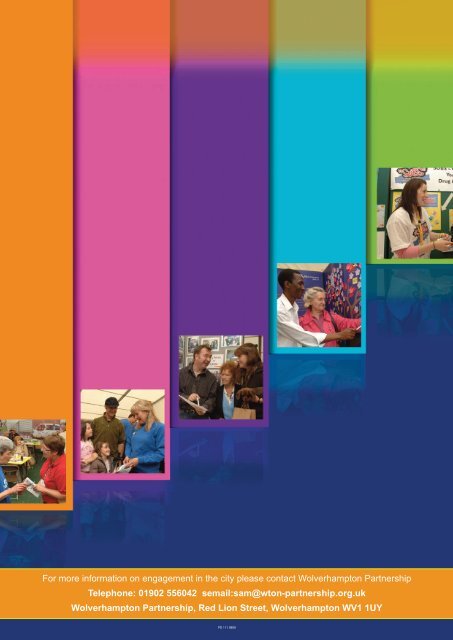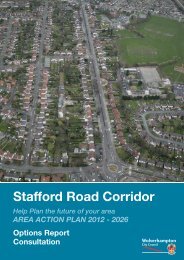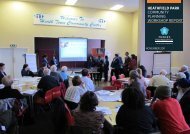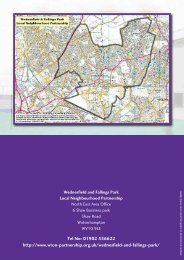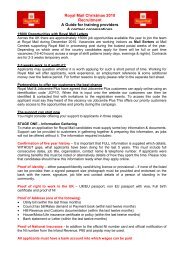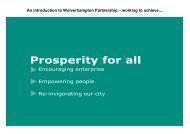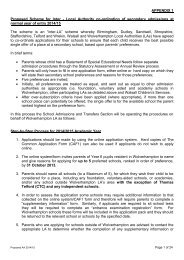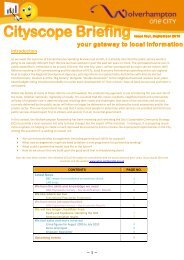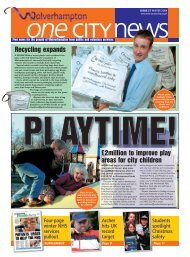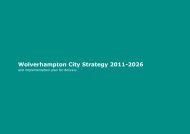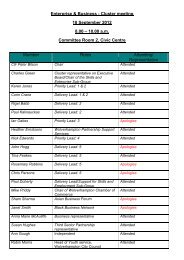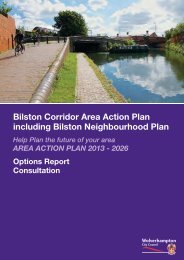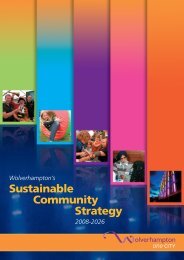Community Engagement Strategy - Wolverhampton Partnership
Community Engagement Strategy - Wolverhampton Partnership
Community Engagement Strategy - Wolverhampton Partnership
Create successful ePaper yourself
Turn your PDF publications into a flip-book with our unique Google optimized e-Paper software.
For more information on engagement in the city please contact <strong>Wolverhampton</strong> <strong>Partnership</strong>Telephone: 01902 556042 semail:sam@wton-partnership.org.uk<strong>Wolverhampton</strong> <strong>Partnership</strong>, Red Lion Street, <strong>Wolverhampton</strong> WV1 1UYPD 111 0809
<strong>Wolverhampton</strong>’s<strong>Community</strong><strong>Engagement</strong> <strong>Strategy</strong>
<strong>Community</strong> <strong>Engagement</strong> <strong>Strategy</strong>IntroductionThis strategy sets out the ways in whichpublic agencies and voluntaryorganisations in <strong>Wolverhampton</strong> willinvolve the public and communities in theservices they deliver and the policies theydevelop; and will support the growth ofstronger communities.The purpose of the strategy is to set outpartners’ agreed approach to communityengagement. By doing this we will also:• Improve decision making• Strengthen communities• Ensure that our priorities are those ofthe community• Build on existing practice• Improve the quality of life for residentsof <strong>Wolverhampton</strong>.<strong>Wolverhampton</strong> has invested significantresources in community engagement inrecent years, underlining the city’scommitment to this area of work.<strong>Wolverhampton</strong>’s investment inneighbourhood working and work withcommunities of interest and identity hasestablished us as a national leader in thefield. In addition, ongoing funding from thePrimary Care Trust has enabled a jointprogramme of engagement activities to bedelivered by the partners and<strong>Wolverhampton</strong> <strong>Partnership</strong>.Increasingly the third and public sectors in<strong>Wolverhampton</strong> are making themselvesmore open, transparent and accountableto the public. This is reflected in the jointcommissioning strategy for the city whichestablishes a common approach tocommissioning across the city which isunderstood, agreed and used by allpartner agencies and key stakeholderswithin the <strong>Partnership</strong>. <strong>Engagement</strong> iscentral to the commissioning process.The developing <strong>Strategy</strong> and Action Planfor Achieving the Environment for aThriving Third Sector will support theabove activity.01
This document has been developed intandem with the Compact Consultationand Policy Development Code of Practiceand is fully compliant with Compactprinciples. **<strong>Wolverhampton</strong> <strong>Partnership</strong> recognisesthat local public agencies and voluntaryorganisations working together andsharing a common approach is the mosteffective way of meeting the essentialneeds of local people in relation to, forexample, community safety, health,education, housing and employment.We recognise that local people have awealth of knowledge and experience asresidents in neighbourhoods and users of* Our definition of engagement and other related terms is included in the appendix to this document** The Compact is a written agreement between the city’s public, voluntary and community sectors. It sets outcommitments made and mutual expectations and it provides a framework for the relationship between theparties to it; it is a requirement by Central Government that a Compact is in place.For further information on The Compact, <strong>Wolverhampton</strong> Sector Counciltelephone 01902 779761<strong>Community</strong> <strong>Engagement</strong> <strong>Strategy</strong>02
public services. We are committed tocontinually improving the ways that weconsult and engage with them. To do thiswe will need to:• Develop an open and honest dialoguewith local people;• Acknowledge the shortcomings ofexisting provision;• Build on what works and learn fromexperience;• Enable and support communityinitiatives.We acknowledge the opportunities offeredby working in partnership with people inneighbourhoods and communities toimprove services and the way they aredelivered.This strategy outlines the ways in whichdifferent organisations will work togetherand the actions that they will take toachieve these aims.Strengthening community engagementwork does not require large sums ofmoney, but rather a commitment to usingresources effectively for example byconducting activities and staff trainingtogether rather than separately.<strong>Community</strong> <strong>Engagement</strong> <strong>Strategy</strong>03
<strong>Community</strong> <strong>Engagement</strong> <strong>Strategy</strong>04
IntroductionThis plan is divided into three sections:The Outcomes:The impact of the workStatement of Values:The basic belief shared by all thoseorganisations providing services inrelation to the rights of local peopleThe Mission Statement:The general intentions of serviceproviders and the principles that will guideour activitiesOutcomesIn its broadest terms, communityengagement contributes to improving thequality of life for <strong>Wolverhampton</strong>’scitizens. The work directly contributes tomeeting local peoples’ needs, serviceimprovements, achieving value for moneyand strengthening communities bybuilding social capital.The high level outcome for this work is‘stronger communities with more localpeople influencing decisions which affectthem.’<strong>Community</strong> <strong>Engagement</strong> <strong>Strategy</strong>05
In addition five priority outcomes havebeen identified:Mission Statement1. There are opportunities for a range oflevels of engagement2. Services are responsive to the needsof service users and residents3. Capacity and social capital is built4. Residents feel that they are informedand that they can influence and shapeservices and policies5. The quality of our engagement isconsistently high and is continuallyimproved.Our action plan, which is appended, setsout actions which will help us to achievethese five outcomes. This will be reviewedand updated every three years.Statement of Values<strong>Community</strong> engagement work reflects ourvalues as a city. We believe it is the rightof all people living in <strong>Wolverhampton</strong> tohave the opportunity to be involved ininfluencing or decision-making about theservices they use or that affect their lives.(See note i).It is the responsibility of the providers ofpublic services to carry out their work inan open, honest and fair way for thebenefit of the residents of<strong>Wolverhampton</strong>.As representatives of the serviceproviders within local public, communityand voluntary agencies, we believe in:• Clear communication;• Providing services that respond to theneeds and interests of service usersand residents;• Developing partnerships with localpeople.PrinciplesThe following principles are set out toguide how service providers approachengagement work. This might includeinitiatives that are organised by largepublic agencies but they equally apply tothe voluntary and community sector andself help activities. (See note iii)<strong>Engagement</strong> is not only about serviceproviders including people in the work oftheir agencies. Public agencies can alsoplay a role in enabling, encouraging andsupporting independent communityinitiatives and development of strongercommunities.In general, the more involved andinformed people are and the moreresponsive service providers become, thebetter services will become. Theprinciples below will enable people toparticipate in this process:<strong>Community</strong> <strong>Engagement</strong> <strong>Strategy</strong>06
<strong>Community</strong> <strong>Engagement</strong> <strong>Strategy</strong>07
ThemePrincipleWays of working• Consistency - a commitment to involve peoplethroughout decision-making processes.• Sustainability – ensuring that new initiatives build onexisting public involvement work.• Evidence – ensure that decisions resulting frompublic involvement are based on evidence andinclude a range of views.• Inclusive – identify strategies for:a. Involving groups who are affected by, but underrepresentedin, decision making processes.b. Obtaining the views of non-users of servicesc. Seeking a wide range of views.• <strong>Partnership</strong> approach – to identify areas of jointresponsibility. To work together where appropriateand possible in order to reduce duplication. To worktogether on developments.• Managing the process – involvement of local peoplein managing the engagement process and enablingall contributors to be heard.• Communication - use of plain language in allcommunications.• Clarity - being clear at the outset about the purpose,boundaries, expectations, limitations and potential ofa public involvement activity.<strong>Community</strong> <strong>Engagement</strong> <strong>Strategy</strong>08
ThemeCreating the rightenvironmentPrinciple• Preparation – adequate planning and preparationbefore undertaking the activity. Providing appropriatetime and information to enable participants tocontribute effectively.• Selecting methods that are appropriate to thepurpose of the initiative.• Feedback – ensuring feedback is given aboutpeopleʼs involvement and the outcomes of theircontribution within an agreed timescale.• Monitor, review and evaluate – public involvementdevelopments using a range of methods e.g.community evaluatorsThemePrinciple<strong>Community</strong> <strong>Engagement</strong> <strong>Strategy</strong>The engagementprocess• Honesty – about expectations or the constraints ofthe activity.• Active listening – service providers really hearingwhat people have to say and respondingappropriately to their interests, concerns, ideas andneeds. Being open to influence.• Recognition – through the use of incentives, forexample, the opportunity to gain qualifications.• Support – identifying what is required to enable localpeople, community groups, service users and staff tofunction effectively as partners. This may includeproducing information in a variety of formats, trainingand access to resources or interpretation.• Flexibility – allowing sufficient time and space toensure participants are able to contribute effectively.• Respect – for people involved in the activity and theskills, knowledge and experience that they bring withthem.• Open, accountable and transparent – about theprocesses of involvement.09
PartnersEach partner organisation will developdetailed action plans in order toimplement this strategy.Please see note ii) for more details.Definition of TermsCOMMUNITY EMPOWERMENT is theoutcome of engagement and otheractivities. Power, influence andresponsibility is shifted away from existingcentres of power and into the hands ofcommunities and individual citizensCOMMUNITY ENGAGEMENT is the actionthat agencies take to enable them toconsult, involve, listen and respond tocommunities through ongoing relationships.CONSULTATION is the process by whichagencies seek advice, information andopinions about strategies, policies andservices. The existing decision makers takethis into account when they makedecisions. This includes many familiaractivities such as surveys, researchprojects, public meetings, user and residentforums.INVOLVEMENT as defined in the Duty toInvolve is an over-arching term that coversproviding information to, consulting with andinvolving citizens in active ways. This caninclude providing people with opportunitiesto influence or directly participate indecision making; to provide feedback ondecisions, services, policies and outcomes,to co-design/work with authorities indesigning policies and services; to coproduce/carryout some aspects ofservices themselves; and to work with theauthority in assessing services.PARTICIPATION is when citizens andcommunities are involved in issues thataffect their lives. They are invited play anactive part in generating ideas as well asmaking the decisions alongside publicsector partners. For instance: participativebudgeting or participative planning.Notesi. This document relates primarily to thepeople that live within the city. Werecognise, however, that people who liveoutside the city make significantcontributions to it or use the serviceslocated here. This includes businesspeople, hospital patients, visitors andstudents. With the exception ofinitiatives specifically related to theresidents of <strong>Wolverhampton</strong>, the views ofthese groups will be included with mostpublic engagement activities.ii. The contributors to this document arefrom a range of agencies that provideservices to the public. They include theCouncil, voluntary and communityorganisations, further, higher and traininginstitutions, health, employment andhousing services providers and thepolice. This booklet has been producedfor their use, to help them improve publicand community involvement activities.iii. <strong>Wolverhampton</strong> <strong>Partnership</strong> hasproduced tools to support organisationsto deliver high quality communityengagement activities.iv. A three year action plan will ensuredelivery of the strategy.<strong>Community</strong> <strong>Engagement</strong> <strong>Strategy</strong>10


